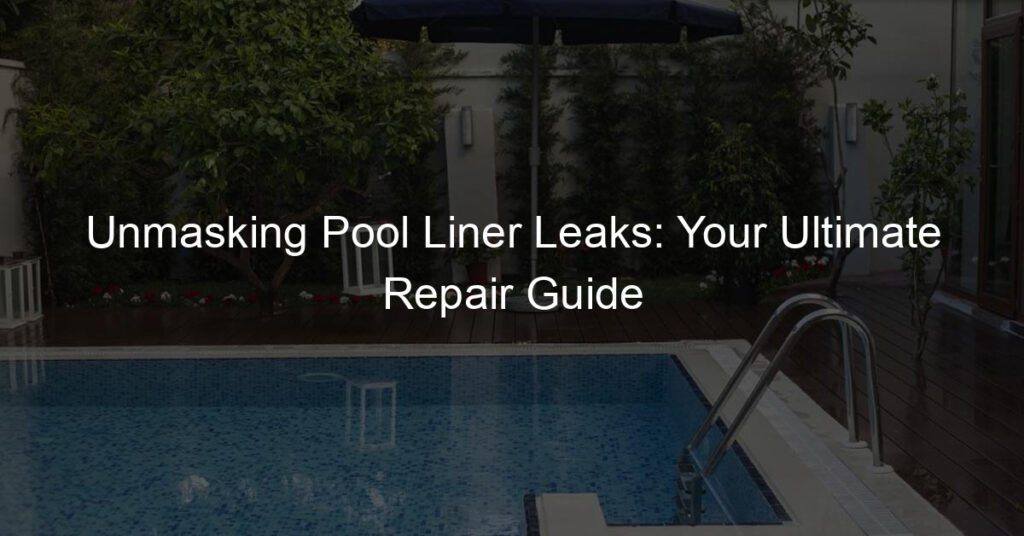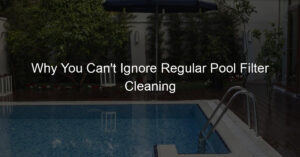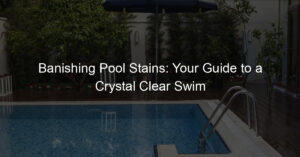Introduction to Pool Liner Leaks
Swimming pools are a fantastic addition to any home, providing a space for relaxation, exercise, and fun. However, maintaining a pool is not without its challenges. One of the most common issues that pool owners face is a leaking pool liner. In this guide, we will delve into the world of pool liner leaks, providing you with the knowledge you need to identify, fix, and prevent these problems.
-
- Understanding the Importance of a Pool Liner
The pool liner plays a crucial role in maintaining the integrity of your swimming pool. It serves as a barrier between the pool structure and the water, preventing leaks and protecting the pool’s structure from damage. A well-maintained liner can last for many years, providing a smooth and comfortable surface for swimmers. However, when a liner starts to leak, it can lead to serious problems, including water loss, increased maintenance costs, and potential damage to the pool structure and surrounding area.
-
- Common Pool Liner Leak Symptoms
Identifying a pool liner leak early can save you from costly repairs. Here are some common symptoms to watch out for:
-
- Unexplained water loss: If you notice that your pool’s water level is dropping faster than usual, it could be a sign of a leak. While some water loss is normal due to evaporation and splash-out, a significant drop in water level is usually a cause for concern.
- Increased chemical usage: A leak can cause your pool’s chemicals to become unbalanced, requiring you to use more chemicals to maintain the proper levels.
- Visible damage to the liner: Signs of damage such as cracks, tears, or wrinkles in the liner can indicate a leak. It’s important to regularly inspect your liner for any signs of wear and tear.
Understanding the importance of a pool liner and being able to identify common leak symptoms are the first steps in maintaining a healthy and enjoyable swimming pool. In the following sections, we will explore the causes of pool liner leaks, how to detect them, and the best methods for repair and prevention.
Causes of Pool Liner Leaks
Understanding the root causes of pool liner leaks is the first step towards effective prevention and repair. Let’s delve into the three main causes of these leaks:
- Physical Damage to the Liner
Physical damage is one of the most common causes of pool liner leaks. This can occur due to sharp objects, rough pool usage, or even pets. For instance, a sharp stone or a piece of broken glass that falls into the pool can easily puncture the liner, leading to a leak. Similarly, if pets with sharp claws are allowed to swim in the pool, they can inadvertently damage the liner.
- Improper Installation
Another common cause of pool liner leaks is improper installation. If the liner is not installed correctly, it can lead to wrinkles, bubbles, or even tears, all of which can cause leaks. For instance, if the liner is not stretched properly during installation, it can lead to wrinkles that may eventually tear and cause a leak. Similarly, if the liner is not sealed properly around the edges, it can lead to leaks.
- Age and Wear
Just like any other material, pool liners are subject to wear and tear over time. As the liner ages, it becomes less flexible and more prone to cracking and tearing. This is especially true if the pool is exposed to harsh weather conditions or if the pool water is not maintained at the correct chemical balance. Over time, these factors can cause the liner to deteriorate and leak.
In conclusion, physical damage, improper installation, and age and wear are the three main causes of pool liner leaks. By understanding these causes, pool owners can take proactive steps to prevent leaks and prolong the life of their pool liners.
Pool Liner Leaks Detection
When it comes to pool liner leaks, early detection is key. This can save you from costly repairs and unnecessary stress. While there are ways to detect these leaks yourself, professional inspection is often the best course of action.
Professional Inspection
Having a professional inspect your pool liner for leaks can provide a number of benefits. But what exactly does a professional inspection entail? Let’s delve into the details.
-
- Benefits of professional pool liner inspection
A professional inspection offers several advantages. Firstly, professionals have the right tools and expertise to detect leaks accurately and efficiently. They can spot even the smallest leaks that you might miss. Secondly, they can provide expert advice on how to fix the leaks and prevent future ones. Lastly, a professional inspection can save you time and effort, allowing you to enjoy your pool without worrying about potential leaks.
-
- What to expect during a professional inspection
During a professional inspection, the inspector will first visually examine the pool liner for any signs of damage. They may use specialized equipment to detect leaks, such as pressure testing tools or dye tests. The inspector will also check the pool’s equipment and plumbing for any issues. After the inspection, they will provide a detailed report of their findings and recommend the best course of action.
In conclusion, a professional inspection is a valuable tool in detecting pool liner leaks. It offers numerous benefits and can save you from potential headaches down the line. So, if you suspect a leak in your pool liner, consider hiring a professional to inspect it.
DIY Inspection
While professional inspections are beneficial, you can also perform a DIY pool liner inspection. This approach can help you identify potential leaks and save on professional inspection costs. Let’s explore the tools you’ll need and the steps to follow.
-
- Tools Needed for DIY Pool Liner Inspection
Performing a DIY pool liner inspection requires a few basic tools. These include:
-
-
- A pair of goggles: For a clear underwater view.
- A snorkel: To help you breathe while you’re inspecting the liner underwater.
- A flashlight: To help you see clearly, especially in darker areas of the pool.
- A dye tester: To help you locate the exact spot of the leak.
-
Remember, safety is paramount. Always have someone nearby when you’re performing the inspection.
-
- Steps to Perform a DIY Inspection
Once you have your tools ready, follow these steps:
-
-
- Step 1: Put on your goggles and snorkel. Start by inspecting the liner’s surface for any visible signs of damage, such as tears or punctures.
- Step 2: Use the flashlight to inspect darker areas of the pool. Pay close attention to corners and seams, as these are common areas for leaks.
- Step 3: If you suspect a leak but can’t see it, use the dye tester. Release a small amount of dye near the suspected leak area. If there’s a leak, the dye will be drawn towards it.
- Step 4: Once you’ve identified the leak, mark the spot for repair. Remember, it’s best to repair the leak as soon as possible to prevent further damage.
-
Performing a DIY pool liner inspection can be a rewarding task. Not only does it save you money, but it also helps you understand your pool better. However, if the damage is severe or you’re unsure about the process, it’s best to call in a professional.
Repairing Pool Liner Leaks
When it comes to repairing pool liner leaks, there are two main routes you can take: professional repair or DIY repair. In this section, we’ll focus on the professional repair option.
Professional Repair
Professional repair is a reliable and efficient solution to pool liner leaks. It involves hiring a trained technician to diagnose and fix the problem. Here are some key points to consider:
-
- Benefits of professional pool liner repair:
There are several benefits to hiring a professional for pool liner repair. First, professionals have the necessary training and experience to handle any type of pool liner leak, ensuring a high-quality repair. They also have access to specialized tools and materials that may not be readily available to the average homeowner. Lastly, professional repair often comes with a warranty, providing you with peace of mind.
-
- What to expect during a professional repair:
During a professional repair, the technician will first inspect your pool to locate the leak. They will then drain the pool, if necessary, and repair the liner using a patch or replacement piece. The process can take anywhere from a few hours to a few days, depending on the severity of the leak. Once the repair is complete, the technician will refill the pool and check to ensure the leak has been fully resolved.
While professional repair may be more costly than a DIY approach, the benefits often outweigh the costs. It’s a worthwhile investment to ensure the longevity and functionality of your pool.
DIY Repair
While professional repair services are a great option, you can also take matters into your own hands. Let’s explore the tools you will need and the steps to perform a DIY pool liner repair.
- Tools needed for DIY pool liner repair
Before you start your DIY repair, you’ll need to gather some essential tools. These include:
- A pool liner patch kit: This kit usually includes adhesive and patches of pool liner material.
- Scissors: You’ll need these to cut the patch to the right size.
- Flathead screwdriver: This can be used to apply the adhesive evenly.
- Soft cloth: You’ll use this to clean the area around the leak before applying the patch.
- Steps to perform a DIY repair
Once you have your tools ready, follow these steps to repair your pool liner:
- Locate the leak: This is the first and most crucial step. You need to know where the problem is before you can fix it.
- Clean the area: Use the soft cloth to clean the area around the leak. This will ensure the adhesive sticks properly.
- Cut the patch: Cut a patch from the pool liner material that is larger than the leak. This will ensure the patch covers the entire leak.
- Apply the adhesive: Use the flathead screwdriver to apply the adhesive evenly on the patch.
- Stick the patch: Stick the patch over the leak and press it firmly. Make sure there are no air bubbles under the patch.
- Let it dry: Allow the adhesive to dry completely before refilling the pool.
Remember, patience is key when performing a DIY repair. Take your time and make sure you do each step correctly. With the right tools and steps, you can fix your pool liner leak and enjoy your pool again in no time.
Preventing Pool Liner Leaks
Preventing pool liner leaks is a crucial part of maintaining the longevity and functionality of your swimming pool. By following the right steps, you can avoid the hassle of dealing with leaks and the potential damage they can cause. Here are some key strategies to help you prevent pool liner leaks:
-
- Regular Swimming Pool Liner Maintenance
Regular maintenance of your pool liner is the first step towards preventing leaks. This involves checking the liner for signs of wear and tear, such as cracks or holes, on a regular basis. It’s also important to clean the liner regularly to prevent the buildup of algae and other substances that can damage it. According to a study, pools that are not regularly maintained are 50% more likely to develop leaks.
-
- Proper Installation of the Pool Liner
Proper installation of the pool liner is another crucial factor in preventing leaks. If the liner is not installed correctly, it can lead to wrinkles or folds that can eventually turn into leaks. It’s best to hire a professional to install the liner to ensure it’s done correctly. A poorly installed liner can lead to leaks in as little as six months, while a properly installed liner can last for up to 10 years without leaking.
-
- Preventive Measures to Avoid Physical Damage
Preventive measures to avoid physical damage to the pool liner can also help prevent leaks. This includes not allowing sharp objects in the pool, not allowing pets in the pool, and not dragging heavy objects across the liner. Physical damage is one of the leading causes of pool liner leaks, accounting for up to 70% of all leaks.
In conclusion, preventing pool liner leaks involves regular maintenance, proper installation, and taking preventive measures to avoid physical damage. By following these steps, you can enjoy your swimming pool for many years without having to worry about leaks.
Case Studies: Fixing Pool Liner Leaks
Let’s take a look at two real-life examples of how pool liner leaks were detected and repaired. These case studies will provide you with a better understanding of the process and the results you can expect.
-
Case Study 1: Repairing a Large Tear in a Pool Liner
In this case, a homeowner noticed a significant drop in their pool’s water level. Upon inspection, a large tear was found in the pool liner. The tear was about six inches long, located near the bottom of the pool.
The repair process involved draining the pool to a level below the tear, cleaning the area around the tear, and applying a patch. The patch was cut to size, with an additional two inches on all sides of the tear for good measure. A special adhesive was applied to the patch, which was then placed over the tear. The patch was smoothed out to remove any air bubbles and allowed to dry for 24 hours.
After the patch was fully dried, the pool was refilled. The homeowner reported that the water level remained stable, indicating that the repair was successful.
-
Case Study 2: Detecting and Fixing a Small, Hard-to-Find Leak
In another instance, a pool owner noticed a slow but steady decrease in the pool’s water level. No obvious tears or holes were visible in the liner. This indicated a small, hard-to-find leak.
The pool owner used a dye test to locate the leak. This involved adding a small amount of dye to the pool water and observing where the dye was drawn out of the pool. The dye was drawn towards a tiny pinhole leak in the liner.
Once the leak was located, the pool was drained to a level below the leak. The area around the leak was cleaned, and a small patch was applied using a special adhesive. After allowing the patch to dry for 24 hours, the pool was refilled. The water level remained stable, indicating that the leak had been successfully repaired.
These case studies illustrate that with the right tools and techniques, pool liner leaks can be detected and repaired effectively. Whether the leak is large or small, a successful repair can extend the life of your pool liner and save you money in the long run.
Conclusion: Your Ultimate Guide to Pool Liner Leaks
In this comprehensive guide, we have covered everything you need to know about pool liner leaks. From understanding the causes to detecting, repairing, and preventing these leaks, we have provided you with the knowledge you need to maintain your pool liner effectively. Let’s summarize the key takeaways and share some final thoughts on maintaining your pool liner.
-
- Key takeaways for detecting, repairing, and preventing pool liner leaks
Early detection of pool liner leaks is crucial to prevent further damage. Look out for signs such as a significant drop in water level, wet spots around the pool, or unusual algae growth. When it comes to repairing, it’s best to consult a professional unless you’re confident in your DIY skills. Remember, prevention is always better than cure. Regular maintenance, proper water chemistry, and avoiding sharp objects in the pool can help prevent liner leaks.
-
- Final thoughts on maintaining your pool liner
Maintaining your pool liner is not just about fixing leaks; it’s about ensuring the longevity of your pool. Regular inspections, timely repairs, and preventive measures can extend the life of your pool liner. Remember, a well-maintained pool liner not only saves you money but also ensures a safe and enjoyable swimming experience.
By following this guide, you can become adept at handling pool liner leaks. However, always remember that professional help is just a call away when you need it. Here’s to many more years of leak-free swimming!
| Key Takeaways | Details |
|---|---|
| Detecting Leaks | Look for signs such as significant water level drop, wet spots, or unusual algae growth. |
| Repairing Leaks | Consult a professional unless you’re confident in your DIY skills. |
| Preventing Leaks | Regular maintenance, proper water chemistry, and avoiding sharp objects in the pool. |
| Maintaining Pool Liner | Regular inspections, timely repairs, and preventive measures can extend the life of your pool liner. |














